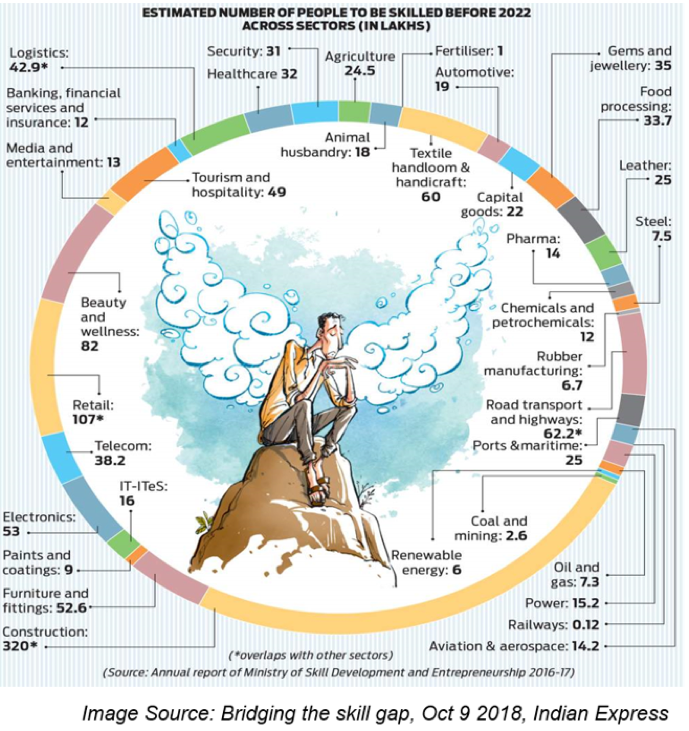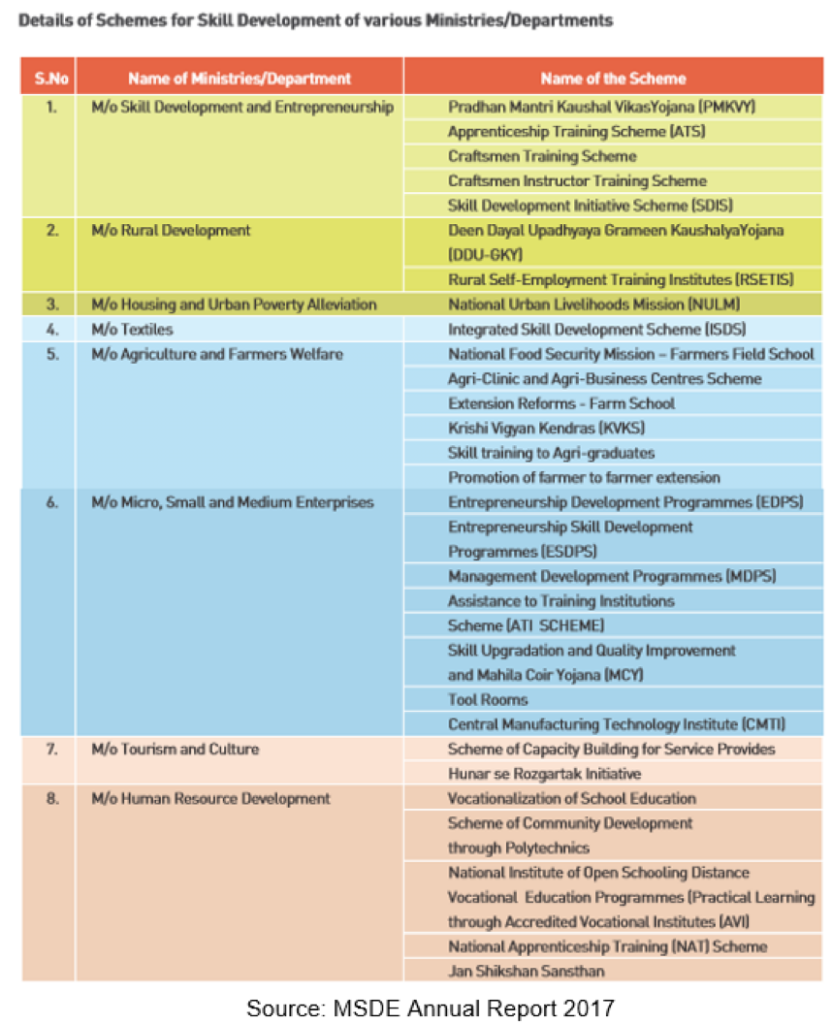There is a lot of noise around the skills-jobs predicament that severely impedes India’s economic prosperity ambitions. Rightly so, given that an estimated 5 million youth are out of work at any given point of time and of the 12-15 million youth approximated to enter the workforce annually over the next decade, around 75 percent are deemed to be not job ready.
One may argue that these estimated figures are often bandied around to trump up alarm around the country’s unemployment crisis. Whichever way you look at it, there is a problem. And it cannot be ignored.
Another angle to it is that of jobless growth, where it has been stated[i] that India lost 7 million jobs over three years to 2015 and the “absolute decline” has continued past 2015 and economic growth has not translated into growth in job numbers.
Where Are the Problems?
As the debate continues we need to look at how the transition of the country’s workforce from the agriculture sector to the industry and services sectors can be improved. This is a key prerequisite to India’s march towards an industrialised economy, at the core of which lies a skilled workforce.
Here, skills refer to those at the bottom of the pyramid. Millions of low-skilled or unskilled agricultural labourers, daily wage workers, school drop-outs who have little or no access to a traditional schooling system or to vocational skills training. What needs to happen to improve the state of skills-based or competency-based training in the country to lift millions out of erratic informal employment into a secure and sustainable livelihood?
To achieve the status of the ‘Skill Capital of the World’ the government has lent a strong voice to skills based training and apprenticeships in the past few years. A plethora of schemes, amendments to the Apprentice Act and drumming up of skill building as a way out of the skills crisis have all resulted in renewed focus on technical and vocational education and training (TVET).
The Apprenticeship Route
Experts believe more can be done. Let’s look at apprenticeships. Only a handful of large firms (PSUs and corporates) offer formal apprenticeships, accounting for around 300,000 formal apprentices in a country with a workforce of around 485 million.[ii]
No one has even best guess estimates on the number of informal apprentices. Reports suggest ‘a majority’ are informal apprentices without any standardisation or legal protection which do little towards any significant skill building in an individual who flits from one job to the other as a means of survival.
So what steps can be taken to support the availability and access to skilled workers at the rate of industry demand which according to the Ministry of Skill Development and Entrepreneurship around 127 million individuals will need skilling between 2017-2022 to be good at their jobs across 34 sectors/sub-sectors.


Three Step Consolidation
Stakeholders of the India Apprenticeship Forum believe a crucial step is to bring about consolidation in all work based learning or ‘earn and learn’ or employability enhancement schemes run by various State Governments and Central ministries. This would result in a massive multiplier effect. The trouble with unbridled enthusiasm at times is that there is a tendency to put out much more than needed. For instance, there are over 40 skilling programmes implemented by more than 16 government ministries (snapshot below), their related departments and agencies. This has led to a highly fragmented and segregated skilling landscape with huge gaps in coordination or standardisation in the workings of the various players.


The Cabinet last year took a welcome step to merge two existing skill building regulatory institutions – the National Council for Vocational Training (NCVT) and National Skill Development Agency (NSDA) – into a new regulator the National Council for Vocational Education and Training (NCVET). This no doubt will remove or reduce some of the problem of duplication of roles and responsibilities of various agencies.
However, the issue of too many cooks still needs work. The new NCVET has the promise of bringing in harmonisation in the workings of Industrial Training Institutes and vocational training providers funded by the National Skill Development Corporation. The Ministry of Human Resource Development remains the regulator for vocational education in schools, and each of the 16 odd Union ministries which oversee training is its own regulator. Additionally, corporates with their own in-built training and apprenticeship programmes are outside the remit of any regulator.[iii]
So the call for consolidation by the IAF’s stakeholders in all work based learning holds a lot of value. Whilst such consolidation will lead to volume by reducing the inefficiencies of duplication further standardisation can be achieved by placing all skilling schemes under the purview of the Apprentice Act. This makes a lot of sense as the basic premise of the various schemes is ‘learning by doing’ which is also the central ethos of apprenticeships.
The third suggested step is for all skilling schemes to be covered by the National Apprenticeship Promotion Scheme. As a corollary of this further consolidation, employers will enjoy much needed clarity on how they can engage in apprenticeships. This will especially benefit and motivate SMEs who have hitherto been largely left out of apprenticeships owing to too much nebulousness in the offerings of the various skilling schemes.
Changes in the Apprentice Act
The Apprentice Act saw a raft of industry friendly changes in 2014 until which it was considered woodenly focused on the industrial era. A view offered by the FICCI President Sandip Somany, is how further changes in the Apprentice Act can boost job creation. The Act currently stipulates that between 2-10 percent of a company’s total workforce is to be employed as apprentices. Sandip suggests the Act should be amended to allow the hiring of even one apprentice by India’s 76 million small scale firms where the average employment is less than six people. Even if half the firms onboard one apprentice each around 40 million jobs get created. Sandip also suggests that the government should up the apprenticeship stipend subsidy from Rs. 15,00 to Rs. 2,500 to make it more attractive for employers to engage in the scheme.[iv]
Another suggestion is a separate ministry solely tasked with employment generation for more accountability and transparency which will cut through all the noise of various statistics bandied around. Tied to this is the need for a robust system for reliable labour statistics. A sentiment we have mooted previously for a comprehensive Labour Management Information System[v] to counter the dearth of comprehensive labour statistics in the country. No system exists today which can be of benefit to all three stakeholders- employers, job seekers and government to draw out a jobs and skills roadmap, identify gaps, examine trends, anticipate changes in the labour market and plan accordingly. In the absence of such crucial data which should become the bedrock of decision making, the jobs-skills mismatch will continue in a vicious cycle.
Summing Up
Deliberation and reflection such as these cut through the rhetoric and mere symbolism of skills training as a pathway to address India’s unemployment challenge. As we have noted time and again, policymaking removed from crucial insight and understanding of what makes for a conducive and progressive skilling ecosystem is highly counterproductive. Assessment of skilling systems to make it more robust is a continuous process requiring the involvement of many facets- regulation being a key element given its intrinsic power to give shape to critical processes.
References
[i]State of Working India 2018, Centre for Sustainable Employment, Azim Premji University
[ii] India’s Skills Challenge: Reforming Vocational Education and Training to Harness the Demographic Dividend, Network for International Policies and Cooperation in Education and Training (NORRAG) blog post by Santosh Mehrotra, Mar 18 2015
[iii] Skill India Now Has a Single Regulator. Will It Succeed Where Other Bodies Have Failed? Santosh Mehrotra, Ashutosh Pratap, Oct 18 2018, The Wire
[iv] Govt should amend Apprentice Act to create more jobs: Ficci’s Sandip Somany, Jan 7 2019, LiveMint
[v] Skill Development in India- Need, Challenges and Ways Forward, 2015, Vandana Saini, Abhinav National Monthly Refereed Journal of Research in Arts & Education














